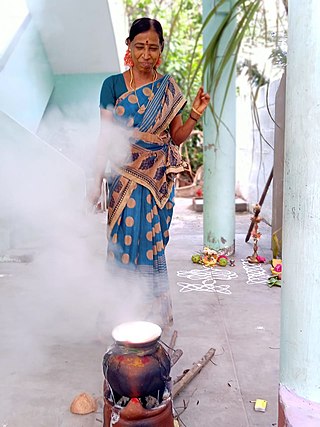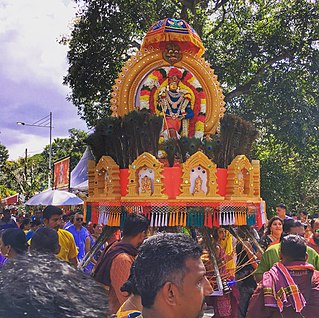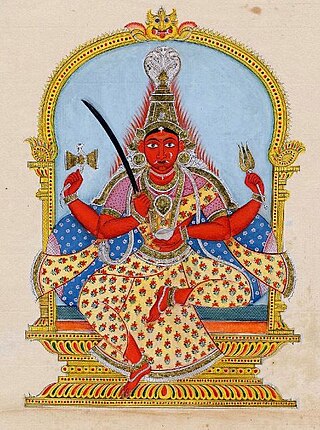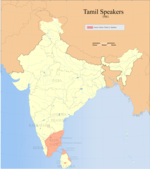In South Africa, Asian usually refers to people of South Asian ancestry, more commonly called Indians. They are largely descended from people who migrated to South Africa in the late 19th and early 20th century from British ruled South Asia.

Pongal, also referred to as Thai Pongal, is a multi-day Hindu harvest festival celebrated by Tamils. It is observed in the month of Thai according to the Tamil solar calendar and usually falls on 14 or 15 January. It is dedicated to Surya and corresponds to Makar Sankranti, the Hindu observance celebrated under many regional names throughout the Indian subcontinent. The festival is celebrated over three or four days with Bhogi, Surya Pongal, Mattu Pongal and Kanum Pongal, observed on consecutive days.

Thaipusam or Thaipoosam is a Tamil Hindu festival celebrated on the first full moon day of the Tamil month of Thai coinciding with Pusam star. The festival is celebrated to commemorate the victory of Hindu god Murugan over the demon Surapadman. During the battle, Murugan is believed to have wielded a vel, a divine spear granted by his mother, Parvati.

Mariamman, often abbreviated to Amman, is a Hindu goddess of weather, predominantly venerated in the rural areas of South India. Her festivals are held during the late summer/early autumn season of Ādi throughout Tamil Nadu and the Deccan region, the largest being the Ādi Thiruviḻa. Her worship mainly focuses on bringing rains and curing diseases like cholera, smallpox, and chicken pox. Mariamman is worshipped in accordance with local traditions such as Pidari or the Gramadevatai. She is considered as a guardian deity by many South Indian village-dwellers.

The Sri Mariamman Temple is Singapore's oldest Hindu temple. It is an agamic temple, built in the Dravidian style. Located at 244 South Bridge Road, in the downtown Chinatown district, the temple serves the majority Hindu Singaporeans, Tamilians, in the city-state. Due to its architectural and historical significance, the temple has been gazetted a National Monument and is a major tourist attraction. Sri Mariamman Temple is managed by the Hindu Endowments Board, a statutory board under the Ministry of Community Development, Youth and Sports.

Puthandu, also known as Tamil New Year, is the first day of year on the Tamil calendar that is traditionally celebrated as a festival by Tamils. The festival date is set with the solar cycle of the solar Hindu calendar, as the first day of the month of Chittirai. It falls on or about 14 April every year on the Gregorian calendar. The same day is observed elsewhere in South and South East Asia as the traditional new year, but it is known by other names such as Vishu in Kerala, and Vaisakhi or Baisakhi in central and northern India.

Hinduism is one of Sri Lanka's oldest religions, with temples dating back over 2,000 years. As of 2011, Hindus made up 12.6% of the Sri Lankan population. They are almost exclusively Tamils, except for small immigrant communities from India and Pakistan.

The Tamil diaspora refers to descendants of the Tamil speaking immigrants who emigrated from their native lands in the southern Indian subcontinent to other parts of the world. They are found primarily in Malaysia, Arab states of the Persian Gulf, South Africa, North America, Western Europe, and Singapore. It can be divided into two main diasporic clusters, due to geographical, historical and cultural reasons, as Indian Tamil diaspora and Sri Lankan Tamil diaspora.

Hindu religion and culture in Singapore can be traced to the 7th century AD, when Temasek was a trading post of Hindu-Buddhist Srivijaya empire. A millennium later, a wave of immigrants from southern India were brought to Singapore, mostly as coolies and indentured labourers by the British East India Company and colonial British Empire. As with Malay peninsula, the British administration sought to stabilise a reliable labour force in its regional plantation and trading activities; it encouraged Hindus to bring family through the kangani system of migration, settle, build temples and segregated it into a community that later became Little India.

Hinduism is practised throughout South Africa, but primarily in KwaZulu-Natal. Approximately 1.1% of the South African population professed to be Hindu, according to the 2011 census. This is down from the 1.4% based on the 1996 census. The 2016 General Household Survey measured a further decline to 0.9%.

Hinduism is the second-largest religion in Fiji, and primarily has a following among Indo-Fijians, the descendants of indentured workers brought to Fiji by the British as cheap labour for colonial sugarcane plantations. Hindus started arriving in Fiji starting in 1879 and continuing through 1920, when Britain abolished the slavery-like indenture system. Fiji identifies people as "Indo-Fijians" if they can trace their ancestry to the Indian subcontinent, Hindus form about 27.9% the population of Fiji.

The Sri Mahamariamman Temple is the oldest Hindu temple in Kuala Lumpur, Malaysia. Founded in 1873, it is situated at the edge of Chinatown in Jalan Bandar. In 1968, a new structure was built, featuring the ornate 'Raja Gopuram' tower in the style of South Indian temples.

The Arulmigu Sri Mahamariamman Temple is a Hindu temple within George Town in the Malaysian state of Penang. The oldest Hindu temple in the state, it was built in 1833, and features sculptures of gods and goddesses over its main entrance and facade.

Arulmigu Sri Mariamman Temple, Samayapuram is an ancient Hindu temple in Tiruchirappalli district in Tamil Nadu, India. The main deity, Samayapuram Mariamman, a form of Adi Parashakti and Mariamman, is made of sand and clay with extractions of medicinal herbs unlike many of the traditional stone idols and is considered as most powerful Goddess, and hence unlike many other Hindu deities there are no abhishekams conducted to the main deity, but instead the "abishekam" is done to the small stone statue in front of it.

Indian South Africans are South Africans who descend from indentured labourers and free migrants who arrived from British India during the late 1800s and early 1900s. The majority live in and around the city of Durban, making it one of the largest ethnically Indian-populated cities outside of India.

The Thimithi or firewalking ceremony is a Hindu festival originating in Tamil Nadu, South India that is celebrated a week before Deepavali, during the month of Aipasi of the Tamil calendar. The fire-walking ceremony is in honour of the goddess Draupati Amman, who is considered the incarnation of goddess Mariamman, and is practiced not only in India, but also in countries with large Tamil populations like Sri Lanka, Fiji, Singapore, Malaysia, Mauritius, Réunion, South Africa and others.

Karuppusamy, also known as Karuppu or Karuppannaswamy is a Tamil god in Tamil Nadu, popular among the rural social groups of Tamil Nadu and Kerala. And also Karuppannaswamy is worshipped by Tamils of Sri Lanka. He is one of 21 guardian deities of Ayyanar, and is one of 21 guardian deities in Dravidian folk religion.

Sri Maha Mariamman Temple, also known as Maha Uma Devi Temple (Thai: วัดพระศรีมหาอุมาเทวี; RTGS: Wat Phra Si Maha Umathewi and Wat Khaek in Thai, is a South Indian architecture style Hindu temple on Si Lom Road in Bangkok, Thailand. It was built in 1879 by Vaithi Padayatchi, a Tamil Hindu immigrant.

Muthumariamman Temple or Arulmigu Sri Muthumari Amman Kovil is a Hindu temple in Matale, Sri Lanka.

Tamil Hindus are the Tamil-speaking people who follow Hinduism.


















